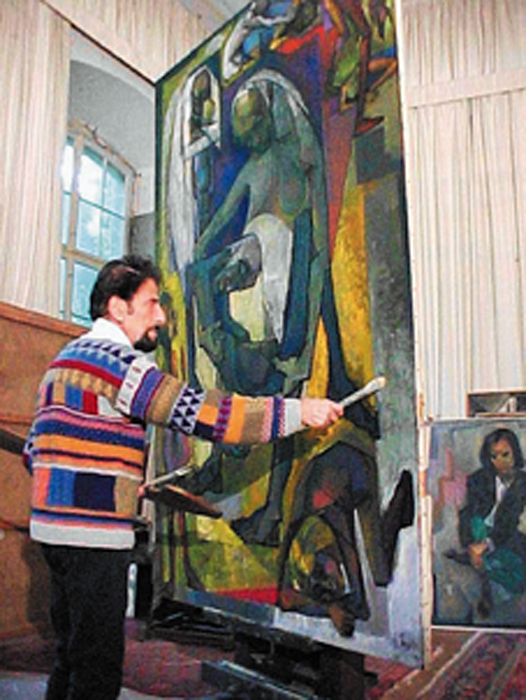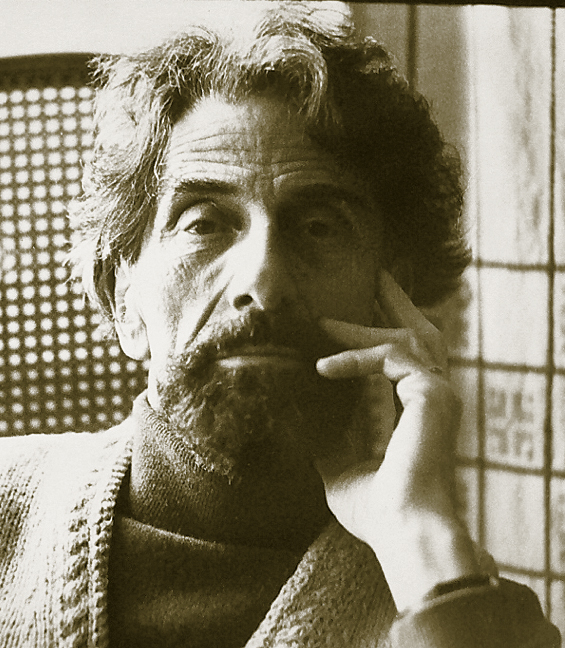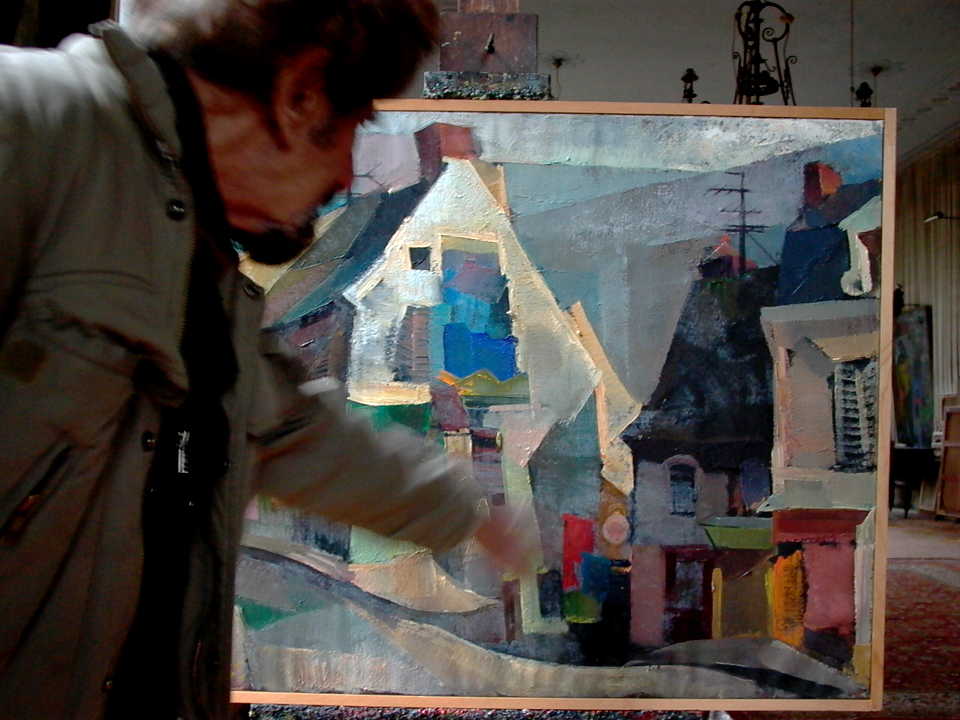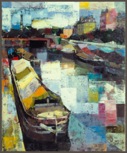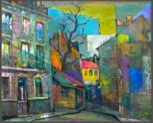Portrait
We
discovered Olivier Foss well tucked away within
the most
hidden section of the Villa des Ternes, a country like area
in the very midst of Paris, where a multitude of artists live
and work, undisturbed by distraction and noise of the metropolis.
The interior of his atelier is dominated by a huge studio easle.
Canvases, records and musical instruments are piled up on a large
couch, on which now and then models pose for the artist,
whereas the great number of books on the shelves made us guess
that an alert and always prospecting spirit is at work within
these walls, a spirit gradually formed and deepened by a great
number of human experiences.
In fact, the life or Olivier Foss has been rather turbulent. Born in Hanover as the son of
a professor of philosophy and a teacher of graphical Arts, Olivier Foss has bathed in
a somewhat cultural fluid since the very cradle, exposed, however, occasionally
to the temptation of some scientific alternative.
After his secondary education in Berlin at the Französische Gymnasium, in Paris
at Lycée Pasteur and Lycée Janson de Sailly, Olivier Foss became the private student
of the artist Fritz Mühsam, then of Paul Colin and of Dupas at the École Nationale
Supérieure des Beaux Arts, Paris.
hidden section of the Villa des Ternes, a country like area
in the very midst of Paris, where a multitude of artists live
and work, undisturbed by distraction and noise of the metropolis.
The interior of his atelier is dominated by a huge studio easle.
Canvases, records and musical instruments are piled up on a large
couch, on which now and then models pose for the artist,
whereas the great number of books on the shelves made us guess
that an alert and always prospecting spirit is at work within
these walls, a spirit gradually formed and deepened by a great
number of human experiences.
In fact, the life or Olivier Foss has been rather turbulent. Born in Hanover as the son of
a professor of philosophy and a teacher of graphical Arts, Olivier Foss has bathed in
a somewhat cultural fluid since the very cradle, exposed, however, occasionally
to the temptation of some scientific alternative.
After his secondary education in Berlin at the Französische Gymnasium, in Paris
at Lycée Pasteur and Lycée Janson de Sailly, Olivier Foss became the private student
of the artist Fritz Mühsam, then of Paul Colin and of Dupas at the École Nationale
Supérieure des Beaux Arts, Paris.
United States
Then, he
worked in the United States of America with the
artists Jacoby and Annot,
who organized his first exhibition at the Riverside Museum in New-York.
His second one-man show took place at the New School for Social Research.
From then on circumstances forced the artist to accept a number of positions : as poster-
designer, book-illustrator, laboratory-technologist, violin teacher, French-instructor etc.,
activities frequently interrupted by the irresistible urge to paint. While doing all sorts
of odd jobs, he exhibited at the World's Fair, at the National Art Club and at the Alma
Reed Gallery in New-York and simultaneously, took a course in life drawing under
Bridgman, at the Art Students League, New-York City.
Olivier Foss accepted a position as instructor of Fine Arts at the University
of Elizabethtown, Lancaster County, Pennsylvania, studying at the same time for his
Bachelor Degree in Science. After his graduation, he taught Bacteriology to a class
of nurses at the woman's Hospital of Philadelphia, while working there as a Laboratory
Technologist. Olivier Foss finds the opportunity to study Medicine at the University
of Basel.
who organized his first exhibition at the Riverside Museum in New-York.
His second one-man show took place at the New School for Social Research.
From then on circumstances forced the artist to accept a number of positions : as poster-
designer, book-illustrator, laboratory-technologist, violin teacher, French-instructor etc.,
activities frequently interrupted by the irresistible urge to paint. While doing all sorts
of odd jobs, he exhibited at the World's Fair, at the National Art Club and at the Alma
Reed Gallery in New-York and simultaneously, took a course in life drawing under
Bridgman, at the Art Students League, New-York City.
Olivier Foss accepted a position as instructor of Fine Arts at the University
of Elizabethtown, Lancaster County, Pennsylvania, studying at the same time for his
Bachelor Degree in Science. After his graduation, he taught Bacteriology to a class
of nurses at the woman's Hospital of Philadelphia, while working there as a Laboratory
Technologist. Olivier Foss finds the opportunity to study Medicine at the University
of Basel.
Paris
But
Art is a faithfully stubborn muse: Foss, at last,
decided
not to resist against her call any longer.
He leaves the University of Basel, breaking peremptorily with
the sciences in order to devote himself entirely to Art.
Back to Paris, he settles down at his atelier in the Villa des
Ternes and exposes in 1949 at the Atelier 5, rue Norvins,
and at the Galerie Hervé in 1950. From 1951 to 1952, the artist
made an exhibition tour through the United States: a one-man
show at the Van Diemen-Lilienfeld Gallery, 57th street,
New-York, in October 1951; a Boston show in January 1952;
an exhibition in Palm Beach, Florida, in February 1952 and in March and April
of the same year at the Coleman Art Gallery in Philadelphia.
not to resist against her call any longer.
He leaves the University of Basel, breaking peremptorily with
the sciences in order to devote himself entirely to Art.
Back to Paris, he settles down at his atelier in the Villa des
Ternes and exposes in 1949 at the Atelier 5, rue Norvins,
and at the Galerie Hervé in 1950. From 1951 to 1952, the artist
made an exhibition tour through the United States: a one-man
show at the Van Diemen-Lilienfeld Gallery, 57th street,
New-York, in October 1951; a Boston show in January 1952;
an exhibition in Palm Beach, Florida, in February 1952 and in March and April
of the same year at the Coleman Art Gallery in Philadelphia.
Path
Exhausted, the artist
returned to Paris in May 1952,
eager to work and to concentrate in solitude. Again he
isolated himself in his atelier, where he elaborated
feverishly his new pictorial projects which had haunted
his mind for many years.
The artists important exhibition in 1953, at the Galerie
Drouant-David, rue du Faubourg Saint Honoré in Paris,
under the heading : "Life's Depths and Summits",
revealed an astonishing evolution, leading up to
the matured synthesis of his ever-present emotions. Each painting shown therein,
represented the Ego in search of its redemption, the desperate voyage through the most
acute stages of our existence : Love, Hatred, Sadism, Crime and Death itself, in which
life's rending conflicts find their supreme solution.
In the year 1956, A. Amante, owner of the Gallery de l'Art Moderne, rue la Boetie,
met the artist at a vernissage and offered him an association, in order to present his
paintings on an international basis. He exhibited the artist's works regularly, from 1956
to 1958 at his own gallery and at the famous Gallery Charpentier, Place Beauvau,
haven of the Ecole de Paris...
eager to work and to concentrate in solitude. Again he
isolated himself in his atelier, where he elaborated
feverishly his new pictorial projects which had haunted
his mind for many years.
The artists important exhibition in 1953, at the Galerie
Drouant-David, rue du Faubourg Saint Honoré in Paris,
under the heading : "Life's Depths and Summits",
revealed an astonishing evolution, leading up to
the matured synthesis of his ever-present emotions. Each painting shown therein,
represented the Ego in search of its redemption, the desperate voyage through the most
acute stages of our existence : Love, Hatred, Sadism, Crime and Death itself, in which
life's rending conflicts find their supreme solution.
In the year 1956, A. Amante, owner of the Gallery de l'Art Moderne, rue la Boetie,
met the artist at a vernissage and offered him an association, in order to present his
paintings on an international basis. He exhibited the artist's works regularly, from 1956
to 1958 at his own gallery and at the famous Gallery Charpentier, Place Beauvau,
haven of the Ecole de Paris...
Years sixty to seventy
With his neighbour,
the painter Armand Nakache, he organized
in 1961 a large common exhibition under the heading :
"Expressionnismes" at the Musée Galliéra in Paris, and,
after a one-man show, 1962, at the Galerie Fragonard
in Metz, it is Switzerland, which offers the artist several
opportunities to show his work : first at the Galerie Goetz,
in Basel, 1964, and in the same year at the Galerie Zünd
in Sankt Gallen, one year later at the Galerie Manuel, in Bern,
and in 1966 at the Heimatmuseum of Rorschach.
At the death of his mother, in 1968, Olivier Foss crossed
the ocean in order to spend some time with his father,
Professor of Philosophy at the Quaker College of Haverford, Pennsylvania.
He then exhibited at the Gallery Janet Fleisher in Philadelphia and shortly afterwards
at the Gallery Lesnick-Walter, on 57th Street, New-York. At this occasion, he met the Film
Producer Raymond Stross who offered him a participation in his next film, "Midas Run",
which was to be started on the same year, in Venice, Italy. So the artist returned to Europe
and took part in the production of "Midas Run", alongside of Fred Astair. Simultaneously,
the artist painted a portrait of the producer's wife : actress Anne Heywood, much
celebrated then, because of her previous role in "The Fox", and exhibited the very paintings
shown in the film, at the Venetian Gallery Paolo Barozzi. Later, but still in the same year,
during the "Festival International du Film", the artist opened an other one-man show at
the Gallery Raymond Journet at Cannes, which was followed, still in 1968, by an important
exhibition at the "Musée de l'Athénée" in Geneva. Back in Paris, the well known Art
Expert, Christian-Gilbert Stiebel, got in touch with the artist, offering him a permanent
representation at his Gallery, rue du Faubourg Saint Honoré.
Olivier Foss exposed there exclusively, from 1972 to 1974. At this time, a book of poems :
"Hinter der Maske" (behind the mask), written by the artist, was edited by Limes,
in Wiesbaden. The German Philosopher, Martin Heidegger, wrote about it,
that "the thoughts therein express and induct reflexion".
in 1961 a large common exhibition under the heading :
"Expressionnismes" at the Musée Galliéra in Paris, and,
after a one-man show, 1962, at the Galerie Fragonard
in Metz, it is Switzerland, which offers the artist several
opportunities to show his work : first at the Galerie Goetz,
in Basel, 1964, and in the same year at the Galerie Zünd
in Sankt Gallen, one year later at the Galerie Manuel, in Bern,
and in 1966 at the Heimatmuseum of Rorschach.
At the death of his mother, in 1968, Olivier Foss crossed
the ocean in order to spend some time with his father,
Professor of Philosophy at the Quaker College of Haverford, Pennsylvania.
He then exhibited at the Gallery Janet Fleisher in Philadelphia and shortly afterwards
at the Gallery Lesnick-Walter, on 57th Street, New-York. At this occasion, he met the Film
Producer Raymond Stross who offered him a participation in his next film, "Midas Run",
which was to be started on the same year, in Venice, Italy. So the artist returned to Europe
and took part in the production of "Midas Run", alongside of Fred Astair. Simultaneously,
the artist painted a portrait of the producer's wife : actress Anne Heywood, much
celebrated then, because of her previous role in "The Fox", and exhibited the very paintings
shown in the film, at the Venetian Gallery Paolo Barozzi. Later, but still in the same year,
during the "Festival International du Film", the artist opened an other one-man show at
the Gallery Raymond Journet at Cannes, which was followed, still in 1968, by an important
exhibition at the "Musée de l'Athénée" in Geneva. Back in Paris, the well known Art
Expert, Christian-Gilbert Stiebel, got in touch with the artist, offering him a permanent
representation at his Gallery, rue du Faubourg Saint Honoré.
Olivier Foss exposed there exclusively, from 1972 to 1974. At this time, a book of poems :
"Hinter der Maske" (behind the mask), written by the artist, was edited by Limes,
in Wiesbaden. The German Philosopher, Martin Heidegger, wrote about it,
that "the thoughts therein express and induct reflexion".
Since the seventies
In
1975, Olivier Foss opened his first complete
retro-
spective exhibition at the Stadttheater of Sankt Gallen.
Visitors from all around the Bodensee gathered there, and
the official and unofficial comments were very favourable.
Back in Paris, the artist exposes in 1976 at the Palais des
Congrès, Porte Maillot in Paris. Then he devoted himself
entirely to the evolution of his style until 1981 and 1982,
when he showed his recent work at the Galerie am Park
in Sankt Galen, owned and directed by Ingrid Merz.
In 1984, Fides Foss organized a one-man show for her husband at the Galerie Ile des Arts,
rue Saint-Louis en l'Ile, followed up by several exhibitions in Switzerland : at the
Art-Gallery directed by Eugen Traber, in Goldach, and at the Bankverein of Sankt Gallen
in 1985, four years later, in 1989, at Bad Horn and at the Kurhaus of Walzenhausen.
After a period of seclusion and creative introspection, we rediscovered Olivier Foss with
a number of new, freely brushed canvases, in 1994 at the Rathausgalerie of Goldach, and
from 1996 to 1999 at the Galerie Burkarthof in Neukirch-Egnach, directed by Kurt Schär,
accredited Swiss expert of modern art.
Presently, Olivier Foss spends most of his time in his atelier with his students, and in front
of some large canvas on his easel, always eager to add to the spiritual content of his work
the aesthetic element which all art requires. In his compositions, Aesthetics is so blended
with expressiveness as to further the latter, instead of undermining it with confusing
and merely decorative details.
Psychology, Mythology and Allegory become the working-tools of the artist, who wants
to convince his spectator, rather than to mystify or amaze him with a display of the latest
aesthetic riddles.A sober and always directly explicit language subdues his own emotions,
as well as those inherent in the subject matter, a language he skilfully masters, making use
of a stylisation, which increases expressiveness and eliminates at the same time the
sentimental, the anecdotic content of his theme.
Olivier Foss, who clings with vehemence to the stormy trend of our time, fulfils the
challenging task to reveal, to enlighten through his art, the heaviest burdens of mankind.
Constructive realism, architectural abstraction, mystical surrealism fuses and solidify into
one compact whole of very personal style, intensity and vision.
spective exhibition at the Stadttheater of Sankt Gallen.
Visitors from all around the Bodensee gathered there, and
the official and unofficial comments were very favourable.
Back in Paris, the artist exposes in 1976 at the Palais des
Congrès, Porte Maillot in Paris. Then he devoted himself
entirely to the evolution of his style until 1981 and 1982,
when he showed his recent work at the Galerie am Park
in Sankt Galen, owned and directed by Ingrid Merz.
In 1984, Fides Foss organized a one-man show for her husband at the Galerie Ile des Arts,
rue Saint-Louis en l'Ile, followed up by several exhibitions in Switzerland : at the
Art-Gallery directed by Eugen Traber, in Goldach, and at the Bankverein of Sankt Gallen
in 1985, four years later, in 1989, at Bad Horn and at the Kurhaus of Walzenhausen.
After a period of seclusion and creative introspection, we rediscovered Olivier Foss with
a number of new, freely brushed canvases, in 1994 at the Rathausgalerie of Goldach, and
from 1996 to 1999 at the Galerie Burkarthof in Neukirch-Egnach, directed by Kurt Schär,
accredited Swiss expert of modern art.
Presently, Olivier Foss spends most of his time in his atelier with his students, and in front
of some large canvas on his easel, always eager to add to the spiritual content of his work
the aesthetic element which all art requires. In his compositions, Aesthetics is so blended
with expressiveness as to further the latter, instead of undermining it with confusing
and merely decorative details.
Psychology, Mythology and Allegory become the working-tools of the artist, who wants
to convince his spectator, rather than to mystify or amaze him with a display of the latest
aesthetic riddles.A sober and always directly explicit language subdues his own emotions,
as well as those inherent in the subject matter, a language he skilfully masters, making use
of a stylisation, which increases expressiveness and eliminates at the same time the
sentimental, the anecdotic content of his theme.
Olivier Foss, who clings with vehemence to the stormy trend of our time, fulfils the
challenging task to reveal, to enlighten through his art, the heaviest burdens of mankind.
Constructive realism, architectural abstraction, mystical surrealism fuses and solidify into
one compact whole of very personal style, intensity and vision.

